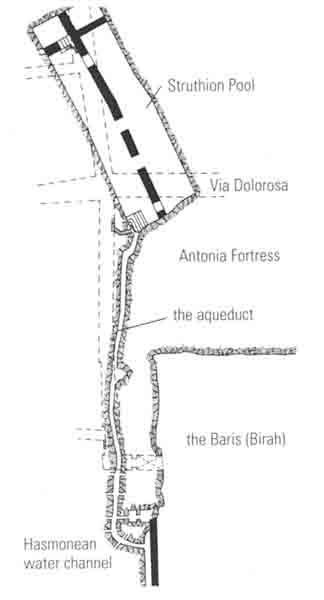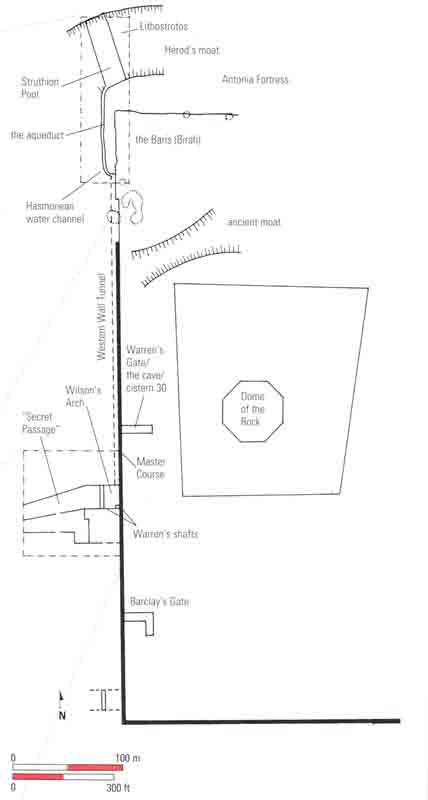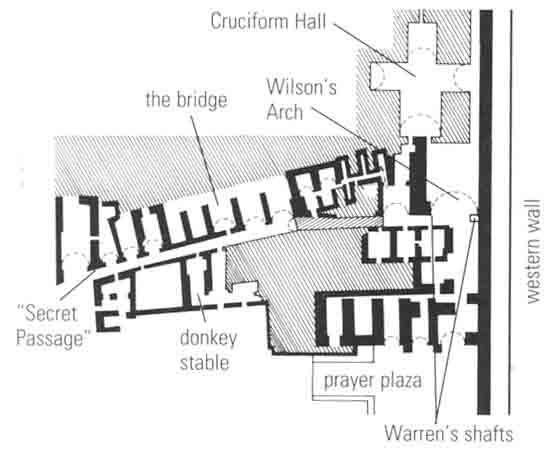030
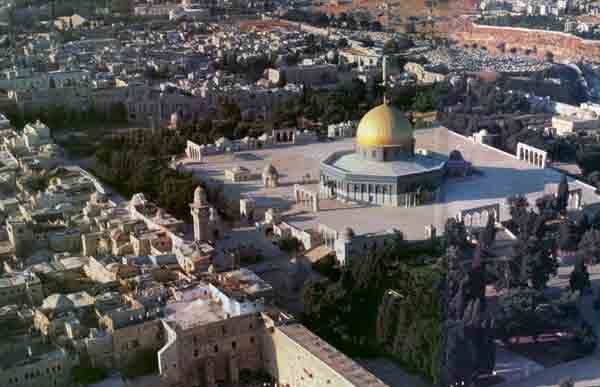
031
Between 1968 and 1982 and from 1985 to the present, Israel’s Ministry of Religious Affairs has exposed over 900 feet of the western wall of the Temple Mount in Jerusalem by digging a tunnel underneath the structures above. During much of that time I was the Israel Antiquities Authority’s District Archaeologist for Jerusalem. That is how, after resigning from the IAA, I became the archaeologist of the site.
It was not your usual excavation, to say the least. But the results have been highly enlightening.
For example, the famous vault, or arch, that we know as Wilson’s Arch, long thought to have been built by Herod the Great, turned out to have been built by the Arab rulers of Jerusalem in the seventh-eighth century C.E.
We can now locate the Hasmonean fortress known as the Baris (or Birah) described in our ancient sources.
We have found pillars that still stand on the street abutting the wall of Herod’s Temple Mount, giving us some idea of how the Temple Mount and its environs looked when pillars like these stood in a long row in front of the western wall.
And we have even uncovered some evidence to locate the limit of the earlier Temple Mount before Herod enlarged it to nearly twice its previous size.
Part of the southern end of the western wall of 032Herod’s Temple Mount has long been exposed. But that is only about 10 percent of its length. At least since the 13th century, the exposed part has been venerated by Jews who pray there, mourning the loss of the Temple above: the First Temple, built by King Solomon and destroyed in 586 B.C.E. by the Babylonians; the Second Temple, built later in the sixth century B.C.E. when the exiles returned; and the Herodian Temple, completely rebuilt and enlarged by Herod the Great between about 20 and 4 B.C.E. and destroyed by the Romans in 70 C.E. Observant Jews do not ascend to the Temple Mount itself for fear of stepping on the sacred part, where the Temple stood. So the long-exposed section of the western wall where Jews come to pray has been regarded as their holiest site—being the nearest point to the Temple’s Holy of Holies where observant Jews are permitted to go.
Because Jews came here to mourn the loss of their Temple, for hundreds of years this part of the western wall was known as the Wailing Wall. Since the establishment of the State of Israel, however, it is called simply the Western Wall (we capitalize it when referring to that part of the western wall of Herod’s Temple Mount set aside for prayer). After Jerusalem was reunited in 1967, this area was enlarged into the plaza that is seen today, ground level having been lowered by about 10 feet to expose more of the grandeur of the western retaining wall, built by King Herod, that enclosed and supported the Temple Mount upon which once stood God’s dwelling place. But there are still some 52 feet of wall below the ground level of this plaza that may one day be exposed. (An often-delayed plan calls for just this.)
North of this section of the western wall is an underground area where many Jews still pray, especially in inclement weather. In this area are two interesting features that have long attracted tourists as well as students of archaeology. They are associated with two famous 19th-century British explorers of Jerusalem, Charles Warren and Charles Wilson. Both worked here in the 1860s on behalf of the London-based Palestine Exploration Fund. For much of our detailed information regarding the Temple Mount and its environs, especially underground, we still rely on Warren’s detailed reports of his excavations and explorations.
032
His method of excavation was to dig deep, narrow, vertical shafts, usually along walls, and sometimes to excavate horizontal tunnels extending from the shafts. Two of Warren’s shaftsa can still be seen, now well lit and covered with wire gratings, in this underground prayer area north of the outdoor prayer area. One of these shafts excavated by Warren, the eastern one, abuts the western wall. By looking down this shaft, we can see 14 additional courses of masonry (one excavated into the rock) to a depth of 52 feet. About 20 feet above bedrock is the original north-south Herodian street that runs along the western wall. The bedrock at the bottom of the shaft is now covered with tourists’ coins thrown into the shaft. The second shaft excavated by Warren in this area is 40 feet to the west, reaching bedrock at the base of the pier of Wilson’s Arch.
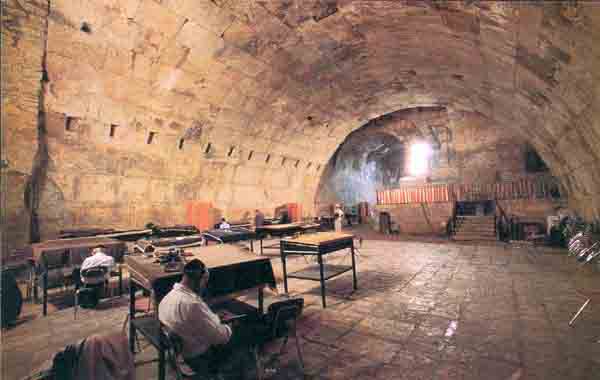
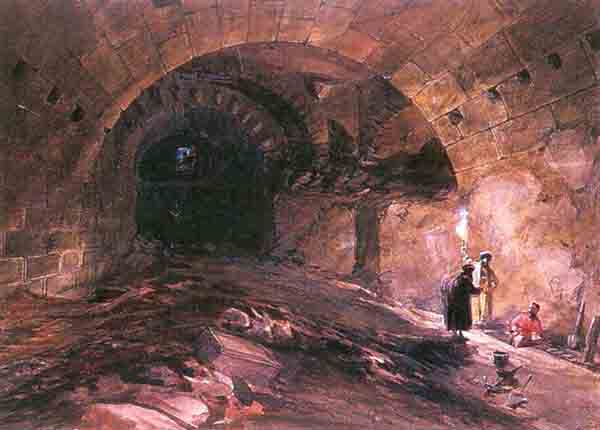
Above these two shafts is a magnificent vault named Wilson’s Arch. It was discovered by Titus Tobler, a Swiss-German explorer of Jerusalem in the 1850s. He relayed his discovery to Wilson, who publicized it. As a result, it became known as Wilson’s Arch instead of Tobler’s Arch. Thereafter, Warren studied the arch intensively, sinking the two shafts we have just described, but the name Wilson’s Arch stuck.
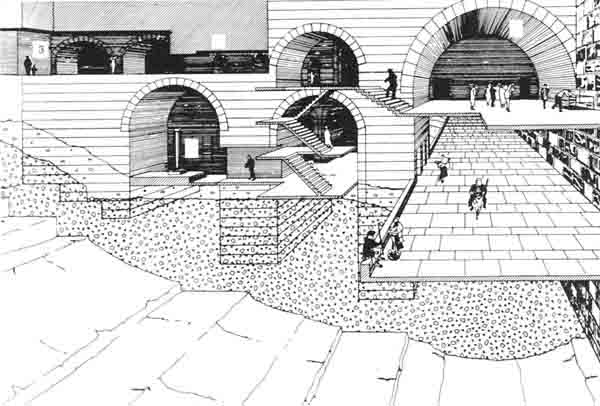
As was correctly recognized almost from the moment of its discovery, Wilson’s Arch supported a bridge that led from the Temple Mount west across the central valley (identified by the first-century Jewish historian Josephus as the Tyropoeon Valley, or, in an incorrect translation, the Valley of the Cheesemakers) to the western hill of the city. But the purpose of the bridge, as indicated by the aqueduct still running above it, was to convey water; it was not principally for human traffic.1 It was built by Herod the Great late in the first century B.C.E. to replace an earlier bridge built, as we are told by Josephus, by the Maccabean rulers and destroyed during Pompey’s conquest of Jerusalem in 63 B.C.E. The source of the water was about 15 miles 034south of Jerusalem, on the other side of Bethlehem, where spring water is collected in three large pools called, incorrectly, Solomon’s Pools. From there water flows north through a channel, which can still be easily traced,b directly to the Temple Mount for priestly use. (Not a single tributary channel leads off the main channel; every drop was reserved for priestly use on the Temple Mount. This gives some idea of the enormous amount of activity that occurred on the Temple Mount at that time.)
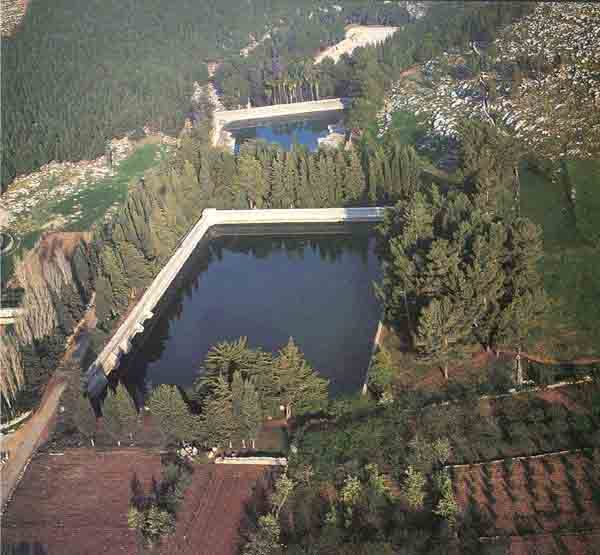
In our investigation of the western wall north of the prayer area, we could see some of the original construction of the pier of Wilson’s Arch that supported this bridge. When Warren excavated his shafts, he found some voussoirs (the springers or trapezoidal stones that fit into the wall and are supported by it) of the Herodian arch supporting the aqueduct, indicating not only its Herodian construction, but also its destruction in 70 C.E. by the Romans. Following the Roman destruction, the aqueduct was rebuilt in the seventh-eighth century C.E. by the Arabs. During the Arab period, there were in fact two abutting, parallel bridges that form the present (that is, seventh-eighth century) bridge.
West of Wilson’s Arch is a late medieval room that Warren called the “Donkey Stable.” An opening in the 035northern wall of this room leads into a long, narrow, east-west passage that Warren called the “Secret Passage.” A 15th-century Arab historian named Mudjir ad-Din described this Secret Passage, which he wrongly attributed to King David, who, Mudjir ad-Din incorrectly thought, had his palace at the Citadel near Jaffa Gate. The Secret Passage, he said, enabled David to go from his palace to the Temple Mount to pray without mixing with the common people. The Street of the Chain still runs above the Secret Passage, and Mudjir ad-Din tells us that whenever people living on the Street of the Chain attempted to dig cisterns under their homes, they dug into this passage. In this, he was correct. Adjacent to the passageway on the north are a series of vaults that originally supported the aqueduct; some of them are still coated with waterproof plaster, indicating that they were indeed later cisterns and that at one time ground level was at the top of the cisterns.c
The lower parts of the vaults in the Secret Passage rest on remains from the late Second Temple period (c. first century B.C.E.). Warren called this entire system, in which first-century B.C.E. and seventh-eighth-century C.E. elements have been combined, the “Great Causeway.” The original first-century bridge and the top of most of the vaults supporting it were destroyed, probably during hostilities associated with the Great Jewish Revolt against Rome (66–70 C.E.). The bridge was not restored until after the seventh-eighth century C.E. Arab conquest. In the Umayyad period (seventh-eighth century C.E.), the Arabs undertook a number of major construction projects in the city, including the palaces south of the Temple Mount and the magnificent Dome of the Rock on the Temple Mount. 037The restoration of the bridge over Wilson’s Arch was probably one of these projects. During the Byzantine period (fourth-seventh century C.E.), Christian rulers had made the Church of the Holy Sepulchre the religious focus of the city. They had left the Temple Mount, site of the destroyed Jewish Temple, a garbage heap to make a point. After the Arab conquest, the focus of sanctity once again turned to the Temple Mount, this time, however, crowned, not with the Jewish Temple, but with the Dome of the Rock and the Al-Aqsa Mosque.
In rebuilding the bridge, the Arabs used the earlier foundations of the bridge and of the adjacent buildings (not the large scattered stones), which were still preserved to a considerable height. The most impressive masonry in this regard is a room Warren discovered and called the “Masonic Hall.” (He named it thus because he speculated that King Solomon’s [!] builders congregated here; being a freemason himself, Warren named it after them. Now it is named the Hasmonean Hall, although it dates to Herod’s time.) The beautiful Herodian walls of the Masonic Hall are preserved to a height of nearly 20 feet. These walls once supported a flat roof and provided part of the support for the Umayyad bridge above. A handsome Herodian cornice is carved into the walls of the Masonic Hall, above which are attached pilasters (engaged columns). Although the tops of the pilasters are barely preserved, Warren discovered the lower part of a Corinthian capital in one corner of the room. This allows us to reconstruct the tops of these pilasters. The flat ceiling, probably made of wooden beams, must have rested on these pilasters. Parts of the walls (the southern and southwestern corner), however, are not original construction. They were built in the Umayyad period (as Warren too observed) to ensure support for the rebuilt bridge above.
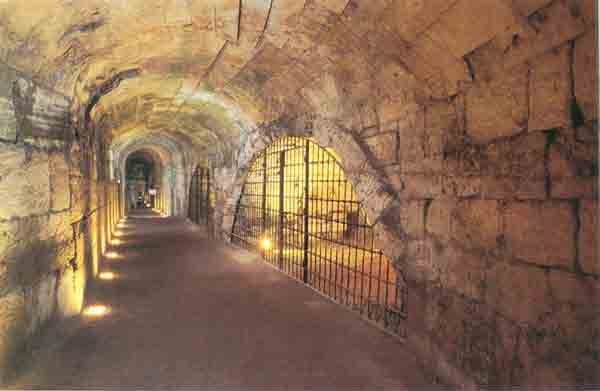
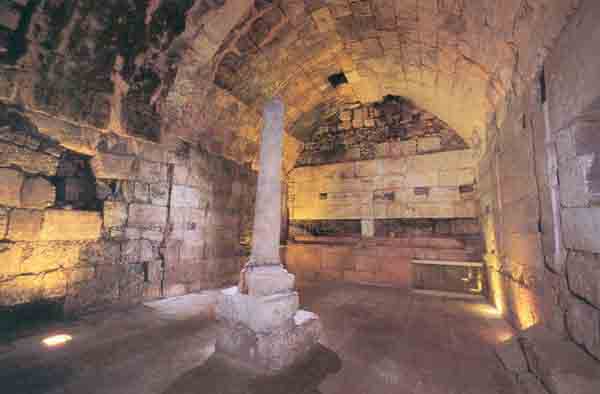
Sometime after the reconstruction of the bridge, an earthquake damaged the building. Eventually it became necessary to support the roof. So, at a time when 2 feet of debris had already piled up in the room, an older column from another structure was inserted in the middle of the hall for support.
The outer wall of the Masonic Hall is partially preserved on the northern and eastern side. It is built of ashlar stones cut in the same meticulous manner as the ones in the western wall of the Temple Mount, as is the Machpelah enclosure of the patriarchs at Hebron 038and the sacred enclosure, commemorating the Tent of Abraham, where he met the three angels at Mamre, near Hebron. These three Herodian structures were of extreme religious and public importance, so it is difficult to escape the conclusion that the Masonic Hall must also have been unusually important. But we have been unable to identify it with any building mentioned in the ancient sources. And we have no idea what it was used for.
The last vault before the western wall is Wilson’s Arch. It is clear that this is part of the later bridge construction (the Umayyad bridge), rather than the original Second Temple period bridge. If we look closely at the voussoirs of this arch, we will see that the stones of the wall adjacent to the springers are broken, chipped and shaved in order to allow the springers to be fitted into the wall. This is a clear sign that the springers were inserted after the wall had been built and therefore date to a later period. The condition of Wilson’s Arch may be compared to that of Robinson’s Arch, a true Second Temple period arch at the southern end of the western wall. There the stones in the wall fit neatly adjacent to the springers because the springers were inserted at the same time the wall was built, not later. Robinson’s Arch supported a monumental staircase leading from the street to the Temple Mount, rather than a bridge.d It is clear, however, that Wilson’s Arch did support a bridge, not only because Josephus mentions the bridge several times, but also because it served as a water aqueduct, and in Herod’s time the only way to convey water over a valley was by a bridge. Syphons were not yet common.
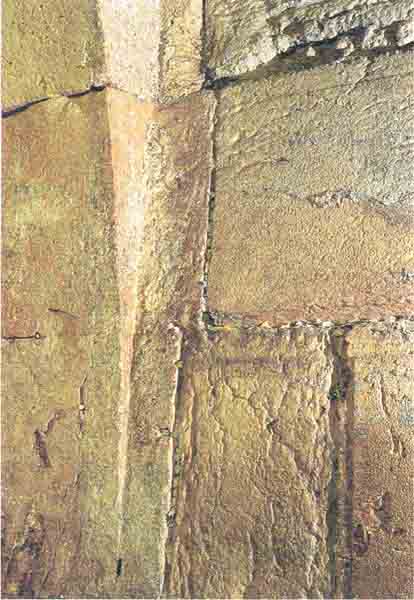

I previously spoke of one of Warren’s shafts 40 feet west of the western wall at the base of the pier of Wilson’s Arch. Warren himself realized that this pier, although originally built in the Second Temple period, was reinforced on its western face in the seventh-eighth century. In fact, the upper part dates to the latter period. The date is established by the pottery discovered there, by historical description and by the architectonic sequence of the building elements in which these remains are “sandwiched” between remains of the Second Temple and Crusader periods. Accordingly, we are forced to conclude that Wilson’s Arch dates to the Umayyad period and is not an original Herodian construction. Where the Umayyad builders could find no Second Temple period foundations on which to build their vaults, they constructed them from scratch. In the case of Wilson’s Arch, however, they used the western wall for the eastern support and rebuilt the partially destroyed Herodian wall on the western end to support it.
During Crusader rule over Jerusalem (1099–1187, 1229–1244), the western wall of the Temple Mount was still entirely exposed, as it had been since Herod’s time and just as it is in the prayer area today. The western wall projected above the city, providing a splendid view of the residential quarters on the western hill. At this time there were only two gates to the Temple Mount, one over the bridge and the other at the northern end of the western wall where ground level rose to nearly the level of the Temple Mount esplanade. Based on an architectonic comparison with Crusader buildings in the area, we can date a number of vaults of the bridge system west of Wilson’s Arch to the Crusader period (12th century). A 13th-century source tells us that the Crusaders built a small chapel on the bridge, known as St. Giles’s (or Aegidius’s) Chapel.2 The Crusaders apparently inserted their foundations into the seventh-eighth-century Umayyad bridge vaults to support the chapel.
After the Arabs expelled the Crusaders, the former decided to connect the Temple Mount more closely to the rest of the city by building up the area immediately to the west of the Temple Mount. The idea behind this was to make Jerusalem a stronghold of Islam by connecting the holy Temple Mount (now the religious focus of the city, crowned by the Dome of 039the Rock) with the city itself. To emphasize the connection, eight gates connected the Temple Mount with the city to the west, and a series of Islamic religious buildings (mosques, religious schools, hospices for pilgrims, monasteries in the Muslim sense, tombs of saints, and the like) were erected along the western wall. Since ground level was much lower than the Temple Mount for most of the length of the wall, it was necessary to construct enormous substructures to support the new religious buildings above them and bring them to the level of the Temple Mount. These buildings covered the entire length of the western wall, including the area now devoted to the prayer plaza. However, an earthquake—probably the earthquake of 1546—destroyed some of the buildings, as well as their substructures, in the present prayer area and its vicinity. Other Muslim structures from this time, however, have survived and can still be seen along the western edge of the Temple Mount.
Proceeding north underground, past the bridge system that Warren called the Great Causeway, we come to a strange large hall built in the form of a four-armed cross, supported by four enormous pillars. But the room was not built by Christians. It probably dates to the Ayyubid (1187–1250 C.E.) or Mamluk (1250–1517 C.E.) period. This cruciform structure provided a substructure to a madrasa (Muslim religious school) built above it. Charles Warren did not reach this cruciform hall. He stopped his exploration of the western wall of the Temple Mount just south of this room. From the eastern end of the Cruciform Hall begins a long, narrow tunnel, newly excavated by the Ministry of Religious Affairs. This tunnel is now 900 feet long, but only 6 feet wide and 8 feet high.
As we walk to the north, the most impressive sight is the beautiful Herodian masonry on our right. The usual course is 4 feet high with typical Herodian stone dressing. Every stone has margins and a prominent central projection (a boss). Both the margins and the bosses have margins of their own. That is, every stone has three margins: the main margin; the margins of the margin; and the margin on the boss or projection. Looking at these beautiful ashlars, we can get some idea of how impressive this wall was when entirely exposed. At one point, about 60 feet north of Wilson’s Arch, we come to what the late Nahman Avigad called the Master Course. Here the stones are 11 feet high! The largest stone in this course is over 42 feet long! It is probably about 14 feet deep. If I am accurately estimating the depth of this stone, it weighs about 600 tons. That’s 1,200,000 pounds. A second stone is nearly 40 feet long and a third is over 25 feet long. The smallest stone is more than 6 feet long. Altogether the Master Course runs over 100 feet and is composed of only four stones.
The problem is not so much how these stones were put in place (they were extracted from a quarry located at the northern end of the western wall, which was higher than this course so the stones could be lowered in place with pulleys), but why. What is the significance of this Master Course of enormous stones? We believe that on the other (eastern) face of the western wall at this point, under the Temple Mount, is an enormous hall. Our theory is that the Master Course 040was installed to support and serve as a counter-force to the vault inside, on the other side of the western wall. Without it, Herod’s builders would have had to place external flying buttresses on the western wall, which of course is unimaginable. It seems that Herod installed a vault here either for structural reasons—to ease the weight of the fill needed to level the Temple Mount and retained by the western wall—or to create a large storage area for the Temple and its priests. To prove the existence of such a subterranean vault, we used radar scanning equipment, echo sound and other similar techniques. The unequivocal answer to these tests: There is a vault inside! Our assumption was correct.
The higher courses of the western wall, over the Master Course, are very uneven. Herod’s magnificent wall was partially destroyed by the Romans in 70 C.E. It lay in ruins until the Umayyad period (seventh-eighth century C.E.), when it was rebuilt, but with less impressive stones. Between then and the end of the 11th century, a number of earthquakes felled some of the reconstructed areas of the wall. Each time the wall was rebuilt, it was with inferior masonry. The result is the assortment of ashlars we see in the upper courses today.
The Western Wall Tunnel has not been excavated down to the Herodian street that runs north along the western wall; the street lies about 20 feet under the beginning of the tunnel. The level of the tunnel remains the same—at the level of the Western Wall prayer plaza—but the Herodian street below it gradually rises as we move north, eventually reaching the level of the tunnel. If the whole tunnel were to be excavated down to street level, we would probably find the same conditions Professor Benjamin Mazar found at the southern end of the western wall—large ashlars 042from the wall toppled onto the pavement during the Roman destruction of 70 C.E.
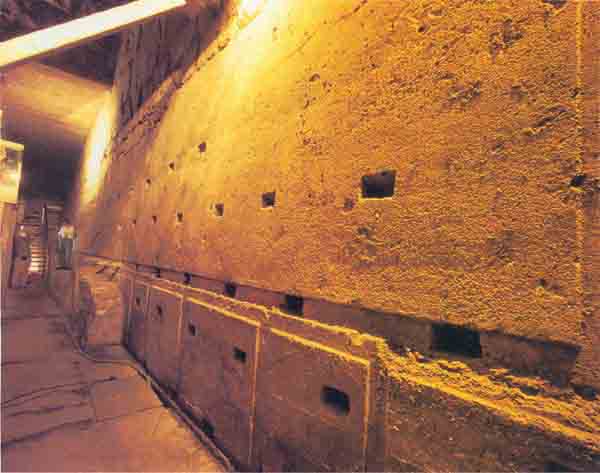
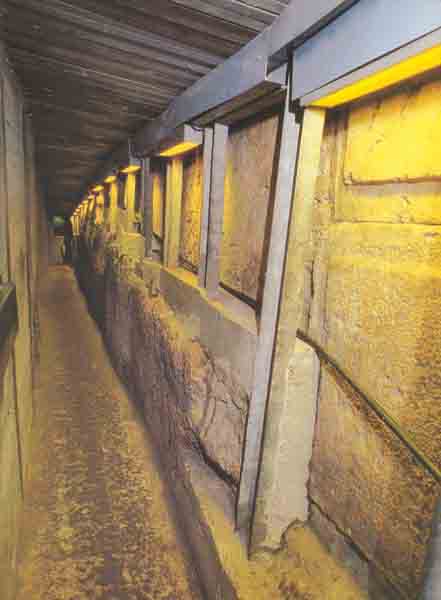
When the Romans rebuilt the city in the second century as Aelia Capitolina (they gave the city a new name in their effort to obliterate any Jewish connection with it), the southern part of the western wall was apparently outside the city; the Roman city did not extend as far south as the Master Course in the tunnel; no Roman remains have been found there. Instead, a large open cistern was installed there. Its eastern wall abutted the western wall of the Temple Mount. Some of the waterproof plaster has survived. In order to attach the plaster to the wall, small square holes were incised into the Master Course and adjacent stones. Into these holes, stone pegs were inserted that served as connecting pins for a thin wall of stones. The plaster was applied to this wall, which was rougher than the Master Course and could more easily hold the plaster. When the cistern was abandoned, the large cruciform structure was built into it.
The Master Course ends (traveling north) at an ancient opening into the Temple Mount through the western wall. This opening is now blocked with small stones mixed with cement made in the late medieval period (12th–14th century C.E.). On the other side of the opening is another cistern that Wilson explored (number 30 of the 38 installations he numbered under the Temple Mount). He never saw the outer face of the gate as we see it now. He knew about it only from the Temple Mount side. The cistern is over 90 feet long, about 16 feet wide and 35 feet deep.
Like Wilson, we believe that this opening was one of the four gates to the Temple Mount from the west in the late Second Temple period described by Josephus. (The other three are the gate above Robinson’s Arch, Barclay’s Gatee and the gate above Wilson’s arch.) In homage to Warren, Wilson named the gate Warren’s Gate.
Recently, we have been able to locate the original Herodian threshold of Warren’s Gate. It was at the level of the lower edge of the Master Course and, as one would expect of Herod, made of one very large stone. This level is exactly that of the threshold of the Double Gate and the Triple Gate on the southern wall of the Temple Mount. The Herodian street at Warren’s Gate, however, is much lower (by several yards) than the level of the threshold to the gate, so there must have been some stairway installation to approach this gate.
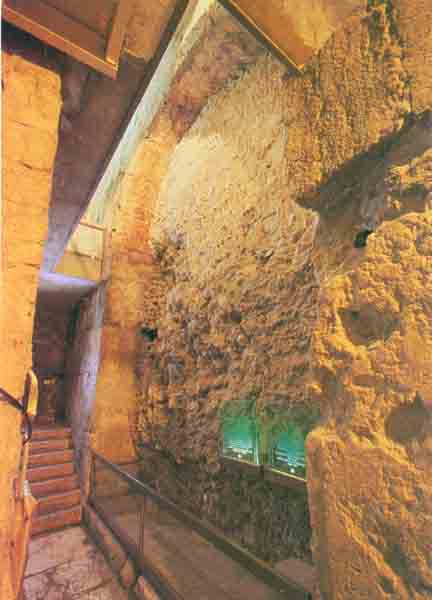
The top of Warren’s Gate is crowned not by a flat lintel, as we would expect from original Herodian construction,f but by an arch with characteristic chamfers exactly like the arches in the Triple Gate on the southern wall of the Temple Mount. These arches are probably 11th-century reconstructions, following the devastating earthquake in this area in 1033 C.E. Indeed the Triple Gate is mentioned in this form for the first time in sources from the 11th century.3 The left 043(northern jamb of Warren’s Gate is clearly different from the original Herodian jamb on the other side, and we may assume this too represents an 11th-century repair. This same repair runs northward until the Herodian masonry once again resumes.
In 1993, while digging a small trench in front of Warren’s Gate in order to lay a foundation for a tunnel-reinforcement wall, we discovered some large paving stone slabs in front of the gate. At first we thought these might be 11th-century pavement stones leading to the threshold of the gate, but it soon became clear that although they did not have the fine quality of Herodian paving stones or the characteristic Herodian marginal dressing, the size of the stones nevertheless indicated they should be dated to the first century B.C.E. (the Herodian era). But it is also possible that they are to be associated with a synagogue in this area described in a cache of medieval documents found in an old synagogue in Cairo in the last century, a cache widely known as the Cairo Genizah.g According to Cairo Genizah documents,4 this synagogue was called the Cave. It occupied the area later occupied by the cistern inside Warren’s Gate, which is large enough to accommodate the synagogue of a small Jewish community—as the Jewish community in Jerusalem was indeed at that time. It too was badly damaged in the earthquake of 1033, 044as we learn from Cairo Genizah documents. Before this it was the main synagogue in the city, and after being repaired it continued as such until the Crusaders took it over in 1099. (Because of its importance, some scholars have assumed this synagogue was on the Temple Mount, rather than under it. Its name, however, clearly suggests otherwise.)
Why was this site chosen for the main synagogue of Jerusalem? It lies due west of the Dome of the Rock, inside of which is the Holy Stone—the Foundation Stone. It was believed then—as it is by many scholars today—that this stone marks the site of the Holy of Holies of the destroyed Temple. Facing east, worshipers who had entered the synagogue from Warren’s Gate would be facing the Holy of Holies at the nearest point to which it could be approached without being on the Temple Mount itself.
Jews used this synagogue after the earthquake of 1033, as shown by Cairo Genizah documents. In 1099, members of the Jewish community in Jerusalem were murdered or driven out by the Crusaders. After the final defeat of the Crusaders in 1244, Jewish life was reestablished in Jerusalem. But by this time the ancient synagogue known as the Cave had become a cistern, the one that Wilson explored and numbered 30. With their synagogue no longer available, the Jews transferred their veneration to a point further south on the western wall, the prayer area that became known as the Wailing Wall. (According to other documents in the Cairo Genizah,5 another way Jews commemorated their lost Temple during the time when the Cave was in use was by walking around the Temple Mount, stopping at each gate to recite a prayer.)
From Warren’s Gate we proceed approximately 500 feet through a narrow part of the western wall tunnel, noticing at first the area that was repaired during the Muslim period and then coming back to the beautiful Herodian masonry. Indeed, the masonry here is especially beautiful. Like the stones at the southern end of the tunnel, each ashlar here has not only a perfectly dressed margin and raised central boss, but each boss and margin has its own margin. Each course of stones is set back about an inch from the course below it.
As we walk north through the tunnel alongside the western wall, we notice that bedrock emerges at the bottom of the wall, rising higher and higher as we go along. Soon the Herodian masonry disappears and gives way to bedrock. But the bedrock itself has been dressed to imitate masonry. Unless we look closely, we will fail to notice that we are looking at bedrock instead of Herodian masonry.
The emergence of this bedrock will help us to identify the limits of the earlier Temple Mount, although it is only one of several factors. King Solomon encircled the small natural hill with a defensive wall, according to the topography of the site, connecting this encircling wall to the city walls of the City of David, south of the Temple Mount. Solomon’s Temple Mount was thus not rectangular. It was confined to this small hill identified in Jewish tradition as Mount Moriah, where Abraham nearly sacrificed his son Isaac (see Genesis 22). This hill is now located under the central part of Herod’s much later Temple Mount. Mount Moriah, as we shall call it, is bordered on the north, east and west by deep wadis (dry valley beds that flow with water only after a winter rain). On the northwest corner the wadi rises, thus creating a vulnerable area, which was fortified by digging a deep moat there. (Charles Warren examined this moat, now filled in, but the Ottoman authorities would not allow him to go to the bottom of it. As a result only its edges are known, although no doubt it had considerable depth as well as width. Its function is clear: It connects the central valley [the Tyropoeon] with a western tributary of St. Anne’s Valley, which borders Mount Moriah on the north.) On the south, Mount Moriah slopes gently down toward the City of David, the spur where Jerusalem was located during King David’s rule. The City of David is well protected on all sides except the north by deep wadis. Later, David’s son Solomon built his palace and the Temple on the small hill north of the City of David that we are calling Mount Moriah. The highest point on this hill is the holy rock under the Dome of the Rock, which is probably the Foundation Stone of Solomon’s Temple.
The pre-Herodian Temple Mount is described in Jewish sources as a square of 500 cubits (about 750 feet). We believe that the Hasmonean (Maccabean) rulers (latter half of second century B.C.E.) created for the first time a square temple platform, like temple platforms in other contemporaneous cities (e.g., Pergamon, where at this time the temple of Athena was surrounded with porticoes). The Book of Maccabees hints in several places (1 Maccabees 4:59–60, 9:54, 12:31, 13:53, 14:36–38) that major construction projects were carried out at this time. Here is another factor that indicates that the Solomonic Temple Mount was confined to Mount Moriah. The literary evidence from Maccabees, along with the moat dug north of Mount Moriah and the emergence of bedrock north of Mount Moriah that has been artificially dressed to look like Herodian masonry, indicate that the square Temple platform was annexed or added to the Temple Mount only during Herod’s time.
In short, the original topography of the area implies that the original Temple Mount was confined to Mount Moriah. North of this hill was a valley or wadi; a moat was dug for added protection where the valley rose at the northwestern corner. When Herod the Great enlarged the Temple Mount, doubling its size, he added to it (north of the earlier Temple Mount) the valley and the moat and part of the hill on the other side of the valley. We shall call this added hill the Antonia Hill because at its pinnacle Herod built the fortress known as the Antonia to protect the new Temple Mount from the north since it was no longer protected by the valley and the moat (which Herod had to fill in).
As we proceed north in the Western Wall Tunnel, we see other evidence of Herodian activity in the area of the Antonia Hill, indicating that earlier it had not 045been included in the Temple Mount. This is a decisive factor in limiting the earlier Temple Mount to the hill to the south, that is, Mount Moriah.
Essentially Herod had to shape the Antonia Hill and the installations around it to meet his needs. To make the bedrock imitate masonry on his new western wall (this wall was further west than the earlier wall), he had to shave off the western part of the Antonia Hill to create a flat surface resembling a wall.
He also cut off part of the top of the hill. This can be seen at the northwestern corner of the Herodian Temple Mount (the present Temple Mount), where the rock scarp thereby created is still visible. Herod used the material from all this shaping to fill in the valley north of Mount Moriah, beginning at the northern end of the platform on which the Dome of the Rock now stands.
As Herod’s workers moved north, reshaping the Antonia Hill and preparing the area for the street running along the western wall, they cut through several pre-existing installations. These included a number of foundation trenches. We considered the possibility that these foundation trenches might be pre-existing water conduits, but the more likely possibility is that they are foundation trenches of walls running east-west from which the ashlars have been long robbed. Some of these trenches are unusually wide—up to nearly 12 feet. This indicates that the building supported by the foundation walls that were originally laid in these foundation trenches must have been massive—probably a fortress. I believe that this marks the location of the building known as the Baris (in Greek)6 or Birah (in Hebrew). The Baris was the fortress built northwest of the pre-Herodian Temple Mount, north of the moat. It is frequently mentioned in various pre-Herodian descriptions of Jerusalem.7 It was probably originally built by the exiles returning from Babylonia in the sixth century B.C.E. (see Nehemiah 7:2). Thereafter it was rebuilt and strengthened during the Hasmonean period (167–63 B.C.E.)8 and used as a royal palace as well as a fort.
When Herod extended the Temple Mount northward, he destroyed the Baris completely, replacing it with the Antonia Fortress on the pinnacle of Antonia Hill.h (Everyone agrees, incidentally, that the Antonia Fortress was located on the pinnacle of Antonia Hill, which can still be seen under the Ummariya school.)
In addition to the two broad foundation trenches, Herod’s workers also severed a cistern. When we discovered this, we checked Warren’s maps and found that he identified several other cisterns that had been severed by Herod. In addition, Herod’s workers also cut through a Hasmonean water system (described below). All these installations were probably associated with the Baris. Finally, a beautifully constructed wall, seen in older photographs of the Temple Mount, may also have belonged to the Baris.9
These recent discoveries regarding the location of the Baris fortress require us to reject Leen Ritmeyer’s suggested location of this building.i Ritmeyer places the Baris adjacent to the northern wall of the pre-Herodian Temple Mount, south of the ancient moat. In fact, it must have been further north—north of the ancient moat, which protected the Baris on the south; and it was considerably larger than shown on Ritmeyer’s sketch. Its size is suggested not only by the ancient descriptions, but also by the size and number of foundation trenches uncovered in the excavation of the Western Wall Tunnel.
046
The northern limit of the pre-Herodian Temple Mount—at the line of the northern edge of the platform on which the Dome of the Rock now sits—also eliminates the suggestion made by Asher Kaufmanj that the Solomonic and Herodian Temples were located north of the Dome of the Rock. If they were located where Kaufman suggests, they would have fallen off the northern side of the then-Temple Mount into a deep gully. On this point I agree with Ritmeyer.
Proceeding north in the Western Wall Tunnel, which maintains the same level along its length, the Herodian street finally emerges because it rises as it proceeds north. The Herodian paving slabs are large and well dressed with handsome margins.
At about this same point we pass through a large pre-Herodian water cistern cut by Herod’s extension of the Temple Mount. Part of it was actually located under the Temple Mount as Herod extended it. The cistern was apparently round, about 25 feet in diameter, with a central column still forming part of the natural rock in which steps had been cut. Three of the steps have survived. The western part of the cistern was incorporated into Herod’s plan for the street running along the western wall of his Temple Mount. He retained the western part as a pool and water source for passersby. At this point the street goes around the pool and then turns northeast to abut the wall once again.
There is a large polished stone in the tunnel at this point that has long been a puzzle. I believe it served as a balustrade on the side of the pool as well as a retaining wall to prevent the slabs of the street from falling into the pool. Although it is limestone, it has been polished, perhaps from long use, to the point that it looks like marble. It now sits in its original position, where it was installed by Herod. It still retains the slabs of the street beside it. (This conclusion is contrary to suggestions that it was put here in secondary use.k)
Walking now on the Herodian street, which continues to ascend as we proceed north, we come to two simple Doric columns in situ that flanked the street on the west. These columns may have marked the entry to a commercial plaza (the Greeks called it an agora, the Romans, a forum and the Italians, a piazza) west of the street. Josephus tells us that numerous markets, storehouses and the like were located in the area included in the so-called Second Wall, which may well have alluded to the area under discussion here.10
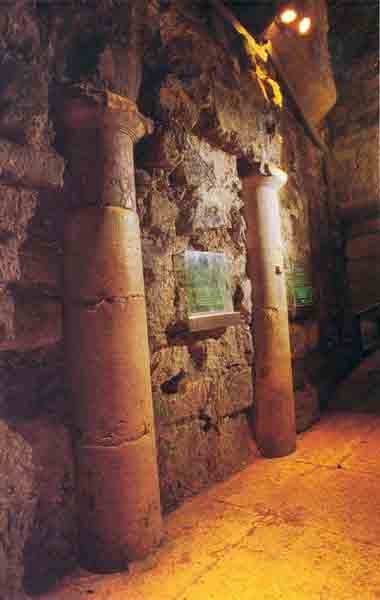
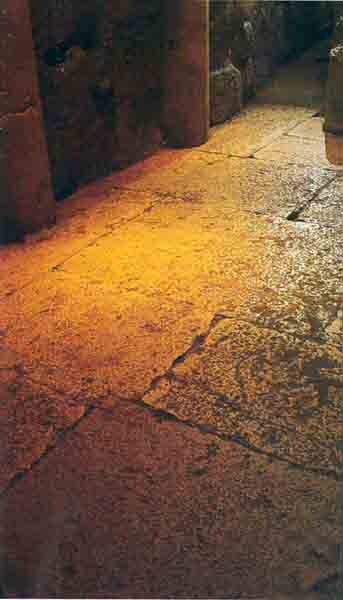
The street ends at natural bedrock that formed part of the quarry from which the stones for Herod’s Temple Mount walls were taken. We can still see some of the grooves cut to remove the stones. One dimension of the stones extracted from here, as indicated by the grooves, is always about 4 feet, the average height of the ordinary courses of the stones in the western wall.
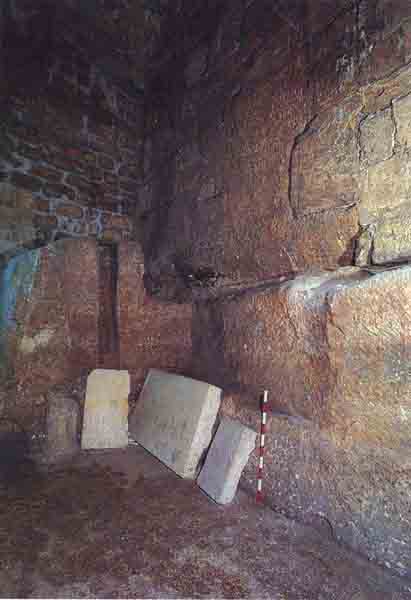
The abrupt end of the Herodian street in this quarry shows that it was never completed. Work was apparently suspended when Herod died in 4 B.C.E. John’s gospel (2:20) tells us that it took 46 years to construct the Herodian Temple, indicating that it was completed only after Herod’s death. At this point, however, the Temple Mount was never completed.
Although the western wall ends at the quarry, the foundation trench for the wall continues. It was cut into the bedrock and left quite small. But it is enough for us to pass between the natural hill and the planned wall that was never built. We soon see that it intersects a channel from an earlier underground water system, which we date to the Hasmonean period (152 to 37 B.C.E.). It is possible that in addition to being a water system it was also a secret passage connecting the Baris to the outside north of the Temple Mount.11 Only a small part of it appears to have been plastered with waterproof plaster, however. It was created by digging down from the surface and then covering the trench with large stone slabs to form a subterranean tunnel. Because the bottom is level and the hill from which it was cut ascends toward the north, the height of the tunnel gradually increases as we move north. At its northernmost end, it is over 35 feet high—an extremely impressive sight.12
At one point, the passage is blocked by a dam about 6 feet high. This was apparently placed here by Herod’s workmen to prevent water from running into the western wall and the adjacent street once the channel had been severed.
Continuing north past the dam, we reach the Struthion Pool in the basement of the Sisters of Zion Convent. When Herod built the Antonia Fortress north of his Temple Mount, he excavated a deep moat north of the fortress. In digging this moat, he dug into the subterranean Hasmonean water system and underground passage. To correct the flow of water at this point, he created a pool in the floor of the moat. The moat was 150 feet wide and this is exactly the length of the Struthion Pool (it is 150 feet long and 50 feet wide). In its present form the pool is the work of the emperor Hadrian in the second century C.E. He divided the pool with a wall, creating two parallel pools, which are covered with pavement that was part of a Hadrianic forum. This beautiful pavement is now in the basement of the Sisters of Zion Convent. This basement pavement was once thought, incorrectly, to be the Lithostrotos, the stone pavement where Pilate condemned Jesus (John 19:13). Even though we now know that it is Hadrianic, it is still called the Lithostrotos Let us retrace our steps a bit in the Hasmonean 047water channel. We can see to the east a small room that was first examined in October 1868 by Claude R. Conder, where he found two attached pilasters. They were partially cut in the rock at this point since the western wall here is in fact bedrock made to look like ashlars. Similar engaged columns were set all the way around King Herod’s Temple Mount, on top of the Temple Mount enclosure wall. A third original pilaster—the only other one left—can be seen in the northern wall of Herod’s Temple Mount, now located in the As‘ardiyyah, a Muslim school building constructed in the Mamluk period.

The Hasmonean water channel now ends at the Struthion Pool. The section north of the pool was partially studied by Warren but is inaccessible today. The water channel probably began about 1,000 feet north of the Old City, where the rainwater was collected. From there it was conveyed to the Baris (since the channel ended north of the moat adjacent to the Baris). It could not have reached the pre-Herodian Temple Mount.
Thus is another chapter in Jerusalem’s captivating history being written.
Between 1968 and 1982 and from 1985 to the present, Israel’s Ministry of Religious Affairs has exposed over 900 feet of the western wall of the Temple Mount in Jerusalem by digging a tunnel underneath the structures above. During much of that time I was the Israel Antiquities Authority’s District Archaeologist for Jerusalem. That is how, after resigning from the IAA, I became the archaeologist of the site. It was not your usual excavation, to say the least. But the results have been highly enlightening. For example, the famous vault, or arch, that we know as Wilson’s Arch, […]
You have already read your free article for this month. Please join the BAS Library or become an All Access member of BAS to gain full access to this article and so much more.
Already a library member? Log in here.
Institution user? Log in with your IP address or Username
Footnotes
This should not be confused with the Warren’s Shaft that is part of the underground water system. See Dan Gill’s “How They Met—Geology Solves Longstanding Mystery of Hezekiah’s Tunnelers,” BAR 20:04.
See “A New Generation of Israeli Archaeologists Comes of Age,” BAR 10:03.
Warren believed that this entire Arab bridge/aqueduct system was part of the First Wall (so-called by Josephus) that protected the Upper City (west of the Temple Mount). It is incorrectly shown as part of the First Wall in the famous model of Second Temple Jerusalem at the Holy Land Hotel.
Warren had already suggested that Robinson’s Arch was not a bridge but rather a staircase, but no one believed his theory.
See Kathleen Ritmeyer and Leen Ritmeyer, “Reconstructing Herod’s Temple Mount in Jerusalem,” BAR 15:06.
See the lintels that have survived at Barclay’s Gate and at the Double Gate on the southern wall in just-cited article.
A genizah is a storage place for worn-out scrolls and other sacred documents that contain the name of God. On the Cairo Genizah, see Raphael Levy’s “First ‘Dead Sea Scroll’ Found in Egypt Fifty Years Before Qumran Discoveries,” BAR 08:05.
The proximity of the Antonia to the Birah led Josephus into an error. He incorrectly stated that the Antonia was formerly named Baris (Josephus Jewish Antiquities 13.307–313; 15.403, 409).
Leen Ritmeyer, “Locating the Original Temple Mount,” BAR 18:02.
Asher S. Kaufman, “Where the Ancient Temple of Jerusalem Stood,” BAR 09:02.
See Murray Stein, “How Herod Moved Gigantic Blocks to Construct Temple Mount,” BAR 07:03.
Endnotes
Amihai Mazar, “The Aqueducts of Jerusalem,” in Yigael Yadin, Jerusalem Revealed (Jerusalem: Israel Exploration Society, 1975), pp. 79–84.
“La Citez de Iherusalem,” XI, in H. Michelant & G. Raynaud, Itineraires á Jerusalem (Osnabruck, Germany: Edition Otto Zeller, 1966), p. 38.
Nasir Khosraw visited Jerusalem in the year 1047; see his Seferrameh, (ed. Ch. Schefer, Paris: 1881), p. 86.
See for example, “The Prayer at the Gates,” Document Taylor-Shecter K27 2a, published fully in Ha’aretz (Israel), 18 May, 1972.
See Josephus, The Jewish War 1.75, 118; See Josephus, Jewish Antiquities 15.403–409 for the Greek; for the Hebrew, see Nehemiah 2:8, 7:2.
Such as in the Pseudepigrapha and Apocrypha: See the Letter of Aristeas 100–104 (third century B.C.E.) and 1 Maccabees 9:4.
Moreover, it became the residence of the Maccabean family until they built a new palace in what is now the Jewish Quarter of the Old City. See Josephus, Jewish Antiquities 14.59; Josephus Jewish War 1.143. The latter palace became the residence of Agrippa II. See Josephus, Jewish Antiquities 20.190 and Jewish War 2.344.
See Y. Nir, Jerusalem and the Land of Israel—In the Footsteps of the Early Photographers (in Hebrew) (Tel Aviv: Defense Ministry Publications, 1986).

